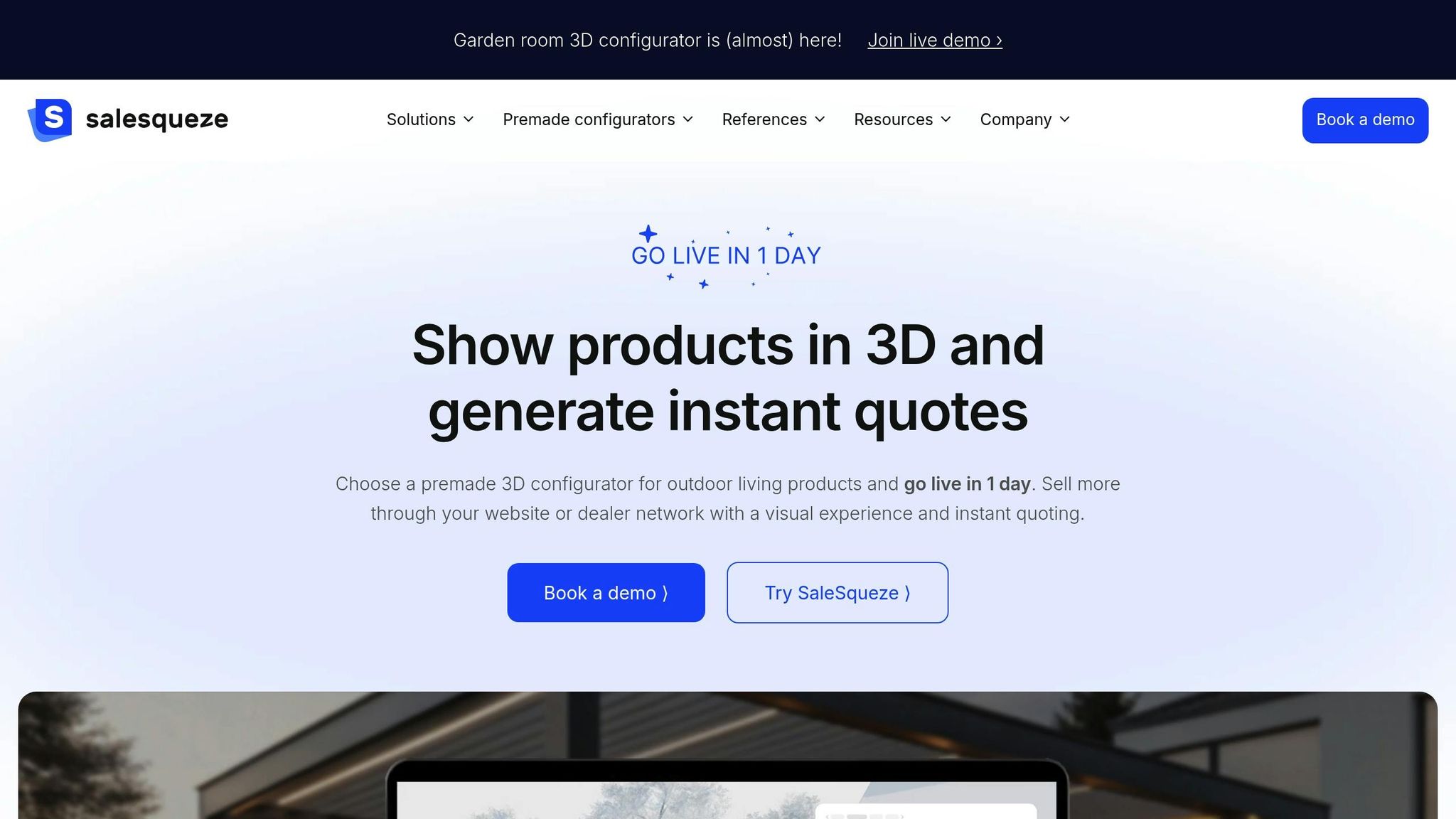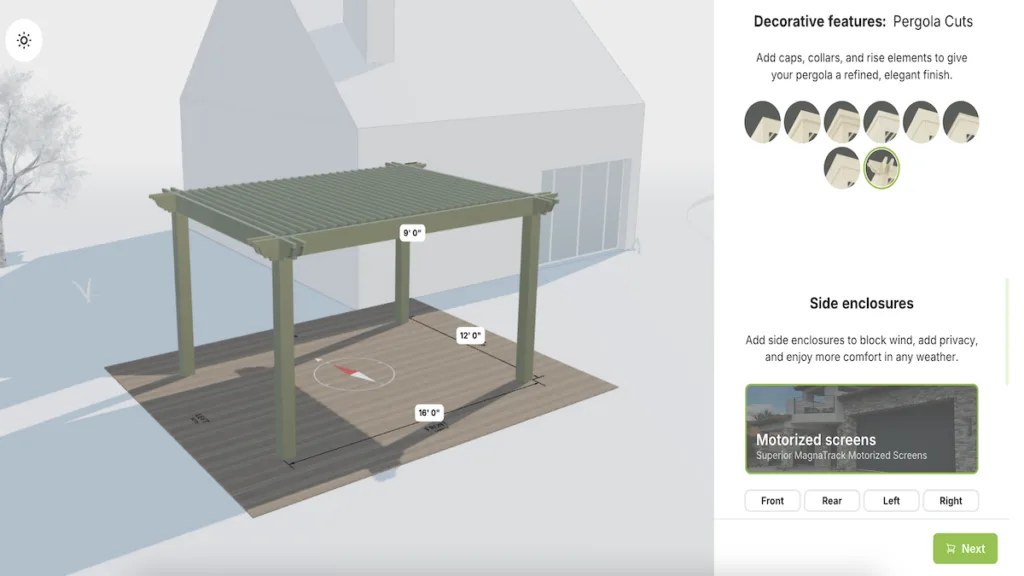3D configurators are transforming how outdoor living product dealers and manufacturers handle quotes. The traditional manual process – plagued by delays, errors, and inefficiencies – often takes 2-3 business days to generate a single quote. This slow pace risks losing customers to competitors offering quicker responses.
With 3D configurators, quotes are generated in minutes, not days. These tools allow customers to visually customize products like pergolas or awnings in real time, while automated pricing ensures accuracy. Sales teams can respond up to 14 times faster, process 4 times more offers, and eliminate costly errors. Businesses adopting this technology have reported a 40% increase in sales within three months and a 5x boost in qualified leads.
Key benefits:
- Speed: Quotes are 70% faster.
- Accuracy: Automated pricing reduces errors.
- Customer Experience: Real-time 3D visuals boost confidence.
- Sales Growth: Higher conversion rates and more leads.
How 3D Configurators Speed Up Quote Generation
3D configurators streamline the quoting process by automating calculations and delivering real-time updates. This means sales teams can provide precise quotes on the spot, while customers get to see and customize their outdoor products visually. Let’s dive into the features that make this possible.
Live Product Visualization and Customization
With 3D configurators, customers can design their product digitally – adjusting dimensions, finishes, or adding features like motorized louvers. The 3D model updates instantly, eliminating the usual back-and-forth and ensuring customer preferences are captured down to the smallest detail. Alongside this, a built-in pricing engine calculates costs in real time. For example, if a customer adds a rain sensor to a motorized pergola, the system immediately adjusts the price to include the component and related installation costs.
Automated Pricing and Order Processing
The configurator’s advanced pricing logic handles everything from base costs to material upgrades and labor, ensuring quotes are both accurate and up-to-date. It doesn’t stop there – once a quote is approved, the tool generates key documents like bills of materials (BOMs), assembly instructions, and files ready for printing. It also automates work orders, schedules installations, and initiates material procurement, simplifying the entire order process.
Sales Process Improvements
These tools make the sales process far more efficient. Sales teams can respond to inquiries up to 14 times faster and manage up to 4 times more offers. The self-service interface empowers customers to explore options on their own, often entering discussions with sales teams already well-informed. With technical details handled by the configurator, sales professionals can focus their energy on building connections and closing deals.
Main Benefits of 3D Configurators for Dealers and Manufacturers
Switching from manual quoting methods to automated 3D configurators brings a host of advantages, including faster processes, improved accuracy, and a more engaging customer journey. These tools directly address common challenges, offering a smoother path to better quotes and stronger sales results.
Faster Quotes with Fewer Mistakes
With 3D configurators, dealers can generate quotes up to 70% faster by cutting out the time-consuming steps of manual calculations, measurements, and back-and-forth communication. What once took hours can now be done in just minutes, allowing sales teams to handle more inquiries efficiently.
Accuracy gets a major boost as well. Unlike manual quoting, which often leads to pricing errors, missed components, or incorrect specifications, automated systems ensure precision with built-in validation and standardized workflows. This not only eliminates costly mistakes but also builds trust with customers.
For manufacturers, standardized quoting across dealer networks simplifies training, ensures consistent pricing, and helps maintain control over profit margins. This uniformity also reduces support requests related to pricing issues, making operations smoother across the board.
Enhanced Customer Experience
One of the standout features of 3D configurators is their ability to create a more engaging and interactive buying experience. Instead of relying on static images, customers can explore realistic 3D renderings that showcase exact dimensions, colors, and features. For example, someone considering a louvered pergola can visualize how it will look in their backyard, eliminating guesswork and boosting confidence in their decision.
By the time customers contact sales teams, they’ve already explored their options and refined their preferences. This means conversations can focus on final details and closing the deal, rather than starting from scratch.
Increased Sales and Better Conversion Rates
The combined effects of faster quotes, improved accuracy, and a better customer experience translate directly into higher revenue. Businesses using 3D configurators often report 5x more qualified leads, while inquiries are processed 14 times more efficiently.
The financial impact is hard to ignore. Many outdoor living companies see a 40% increase in sales within just three months of adopting 3D configurators. This growth stems from higher conversion rates and the ability to manage a larger volume of prospects. Manufacturers also benefit, as standardized quoting processes across dealer networks lead to higher order volumes and more consistent revenue.
These advantages lay the groundwork for a smooth implementation process, which will be discussed next.
How to Set Up a 3D Configurator: Step-by-Step Guide
Launching a 3D configurator can be a straightforward process, often taking just 2-4 weeks when approached methodically. Here’s how to break it down into manageable steps.
Setting Up Product Data and Pricing Rules
Start by organizing your product catalog into clear categories and variations. For outdoor living products, this means defining base models, size options, color choices, and add-ons for each product line. For instance, if you’re working with louvered pergolas, document all the roof styles, frame sizes, and compatible accessories to ensure customers can only select options that work together.
Pricing rules deserve extra care since they directly affect your profitability. Set base prices for standard configurations and create markup rules for premium features, larger sizes, or special materials. For example, you might add a 15% markup for premium aluminum finishes or charge an additional $500 for motorized louvers. Don’t forget to account for regional pricing differences – labor costs, shipping fees, and permit requirements can vary widely. A pergola installation in California, for example, might be 20% more expensive than the same project in Texas.
Once everything is documented, test your pricing logic against various scenarios. This step is critical to avoid costly pricing errors and ensure accuracy before going live.
Adding Your Brand to the Configurator
Make the configurator feel like an extension of your brand. Upload your logo, use your website’s color scheme, and select fonts that reflect your style. The 3D models should be as realistic as possible, showcasing accurate textures, finishes, and even small details like hardware and connections. Customers should feel confident that what they see is what they’ll get.
Customize the interface to align with your sales approach. For example, if you discuss budgets early in the process, include price indicators throughout the configurator. If your focus is on design flexibility, highlight customization options and provide visual previews. Different audiences may also require tailored experiences. Homeowners might prefer detailed explanations and design inspiration, while contractors may want streamlined options and bulk pricing displays. Some businesses even create separate versions of the configurator for these groups.
Lastly, build trust by including your contact information, business hours, and service areas. This reassures customers they’re dealing with a reliable, accessible company and encourages them to move forward with their inquiry.
System Integration and Support
Once your product data and branding are ready, integrate the configurator with your existing systems to make operations seamless. For example, linking it to your CRM ensures that every lead generated goes directly into your sales pipeline, complete with all configuration details and customer contact information.
Set up automated email workflows to follow up with customers immediately after they complete a configuration. Send a detailed quote, product specifications, and next steps to keep them engaged while their interest is fresh.
If you manage inventory, integrate the configurator with your inventory system to reflect real-time availability and provide accurate delivery estimates. This is particularly important if lead times vary based on stock levels or supplier schedules.
Choose a platform that allows for easy updates as your products or pricing evolve. For instance, solutions like SaleSqueze feature user-friendly admin panels where you can adjust configurations, update pricing, or add new products without needing coding expertise.
Don’t overlook the importance of training your team. Sales staff should know how the configurator works, what information it provides, and how to use the generated quotes effectively in customer conversations. Practice different scenarios to ensure everyone is comfortable using the tool.
Finally, monitor key metrics like completion rates, popular configurations, and quote-to-sale conversions from the start. This data will help you identify which products resonate most with customers and where they may encounter roadblocks in the process. By tracking these insights, you can continuously refine the configurator to boost both efficiency and sales.
sbb-itb-ec816af
Case Study: SaleSqueze‘s 3D Configurator Results

Faster Quoting and Ordering for Outdoor Living Products
This case study brings the benefits of SaleSqueze‘s 3D configurator to life with data that speaks volumes. By implementing the platform, businesses saw a 70% reduction in quote generation time, turning what used to take hours into a task completed in just minutes.
One of the standout features is the configurator’s ability to be deployed in just one day. Unlike traditional custom development projects that drag on for months, SaleSqueze’s pre-built framework – designed specifically for outdoor living products – eliminates the need for lengthy development cycles.
The efficiency improvements go far beyond speed. Dealers using the platform processed inquiries 14 times faster compared to manual methods and generated 4 times more pergola offers. This leap in productivity is made possible by the platform’s automated processes, which handle customer inquiries 24/7 without requiring staff involvement. This around-the-clock automation means businesses can capture leads outside regular business hours and cater to customers across different time zones throughout the U.S.
These operational upgrades didn’t just save time – they also delivered substantial financial benefits.
Actual Business Results
The results from businesses using SaleSqueze’s 3D configurator are nothing short of impressive. On average, companies reported a 40% increase in sales within just three months of adopting the platform. Some dealers even managed to double their sales during this period.
Lead generation improvements were even more dramatic. Businesses reported a 5-fold increase in qualified leads, with one customer achieving a staggering 486% boost in leads and quotes generated. In one standout example, the system generated $10 million worth of quotes in its first month, with another instance producing 40 quotes valued at $10 million. These figures underscore the platform’s ability to handle high-value transactions and manage significant quote volumes with ease.
U.S. Market Features
SaleSqueze’s configurator is finely tuned to meet the needs of the U.S. market. All pricing is displayed in U.S. dollars ($), with proper formatting for thousands separators (e.g., $15,000). Measurements are presented in feet and inches, aligning with American standards, and temperature settings for climate-related features are shown in Fahrenheit.
Recognizing that many customers browse and configure products on mobile devices, the platform is fully optimized for smartphones and tablets – an essential feature for the outdoor living market. It also accommodates regional pricing variations, allowing dealers to adjust base prices and markups to reflect local factors like labor costs, permits, and shipping expenses specific to various states and regions.
To further streamline operations, the configurator integrates seamlessly with popular American business tools, including CRM platforms and email marketing systems. This ensures that leads flow directly into existing sales pipelines, complete with all configuration details, so businesses can maintain efficiency throughout the entire sales process.
Conclusion: How 3D Configurators Change Quote Processes
3D configurators are reshaping how businesses handle quotes, transforming what used to take hours of manual effort into a streamlined process completed in minutes with precise automation. This shift is revolutionizing the outdoor living industry across the U.S., offering both businesses and customers a more efficient and engaging experience.
Companies leveraging platforms like SaleSqueze are seeing major efficiency improvements, processing inquiries up to 14 times faster than traditional methods. Features like real-time 3D visuals and automated pricing not only cut down on errors but also reduce miscommunications and the need for time-consuming quote revisions, speeding up the entire sales process.
For customers, the benefits are just as striking. Instead of waiting days for quotes or struggling with unclear designs, they can instantly customize, explore, and price products. Realistic 3D views of items like pergolas and glass roofs help build confidence in their choices right from the start. These enhancements lead directly to increased customer satisfaction and, ultimately, business growth.
Modern configurators are designed to meet local needs effortlessly, handling U.S.-specific requirements like dollar formatting, feet-and-inches measurements, and compatibility with American business tools. With mobile optimization, customers can create configurations anytime, anywhere, helping businesses capture leads that might otherwise slip away. Additionally, by reducing reliance on printed brochures and manual 3D renderings, these tools save time, cut costs, and ensure customers always see the most up-to-date product offerings.
The competitive edge is undeniable. While traditional methods delay responses, businesses equipped with 3D configurators can respond instantly, generate more quotes, and close more sales. Reports of a fivefold increase in qualified leads and 40% sales growth within just three months underscore the tangible impact on business performance. Plus, these tools are easy to update and require minimal training, making them accessible for companies of all sizes.
As the outdoor living industry continues to evolve and customer expectations rise, adopting 3D configurators ensures your business stays ahead of the curve. The technology delivers proven results, measurable growth, and can be implemented in as little as one day.
FAQs
How do 3D configurators make quotes more accurate than traditional methods?
3D configurators take the guesswork out of quoting by leveraging real-time data and automated rules to minimize manual errors. As customers make their selections, these tools automatically adjust pricing and configurations, ensuring quotes are precise and reflect up-to-date costs and available options.
Traditional methods often depend on static documents or manual calculations, which can be time-consuming and prone to mistakes. In contrast, 3D configurators simplify the process by instantly creating accurate, customized quotes. This not only saves valuable time but also enhances the customer experience by delivering transparent and dependable pricing.
How do I set up a 3D configurator for outdoor living products?
Setting up a 3D configurator for outdoor living products begins with clear planning. Start by defining what you aim to achieve and deciding which products and customization options you’ll offer. This step is crucial for ensuring your configurator meets both your business needs and customer expectations.
The next step is creating detailed 3D models of your products. These models should accurately reflect every feature and variation available, so customers can see exactly what they’re getting. Precision here is key – it’s what makes the configurator feel reliable and professional.
Once your models are ready, integrate them into a platform that supports seamless customization. A user-friendly interface is essential. Make it simple for customers to explore options, make changes, and visualize their choices in real-time. This intuitive experience can make all the difference in converting interest into sales.
Before going live, test the configurator thoroughly. Check for any glitches, ensure smooth navigation, and confirm that the overall experience is enjoyable and frustration-free.
Platforms like SaleSqueze can make this process easier. They offer tools to build visually appealing configurators that not only enhance the customer experience but also simplify quoting and ordering for outdoor living products.
How do 3D configurators improve the buying experience for customers?
3D configurators elevate the shopping experience by giving customers the power to interact with and personalize products in real time. These tools offer detailed, visual displays that let shoppers explore products from various angles and tweak features such as size, color, and accessories. This hands-on approach helps customers better understand their options, making them more confident in their decisions.
By creating a more engaging and transparent buying process, 3D configurators build a stronger connection between customers and their purchases. This not only boosts satisfaction but also simplifies decision-making, making the entire process quicker and more enjoyable.

